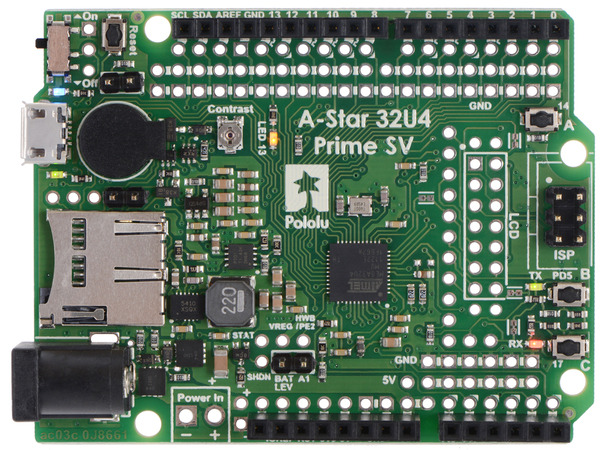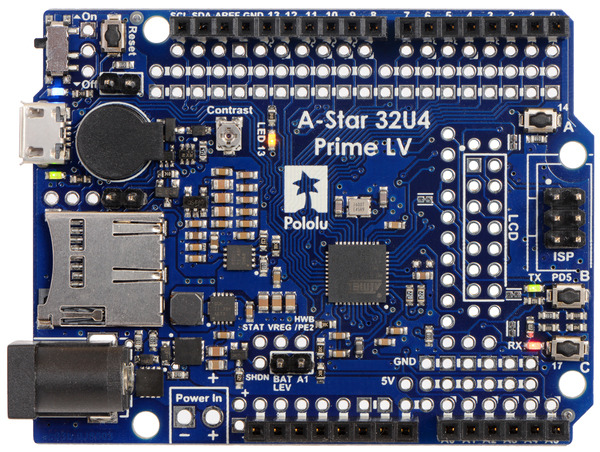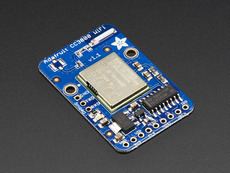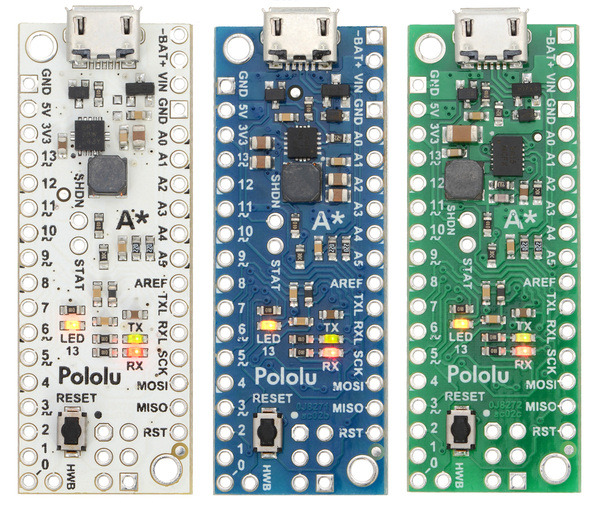Pololu Blog » Posts tagged “arduino” »
Posts tagged “arduino” (Page 4)
You are currently viewing a selection of posts from the Pololu Blog. You can also view all the posts.
Popular tags: community projects new products raspberry pi arduino more…
New product: A-Star 32U4 Prime SV
It has been snowing on and off today in Las Vegas, but luckily the weather was not bad enough to delay our last product release of 2014: the A-Star 32U4 Prime SV. We hope that this and the other A-Stars we released this year will help bring success to your projects in 2015. Thanks for your business and support in 2014, and Happy New Year!
The A-Star 32U4 Prime SV, our newest A-Star, is an Arduino-compatible board with a switching regulator that allows an input voltage range of 5 V to 36 V. Like the A-Star 32U4 Prime LV we released earlier this month, the A-Star 32U4 Prime SV shares the pinout and form factor of the Arduino Leonardo and should work with compatible shields.
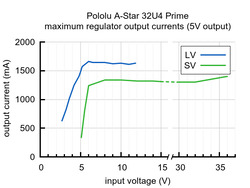 |
What really sets the A-Star 32U4 Primes apart from competing products is their power supply system based on high-efficiency switching regulators, which allow plenty of power to drive your microcontroller and lots of peripherals over a large range of input voltages. The A-Star 32U4 Prime SV uses the Intersil ISL85410 1-Amp buck regulator, a more powerful relative of the regulator on A-Star 32U4 Mini SV. So you get 1 A at 5 V over most of the SV input voltage range. (We recommend an input voltage of at least 6 V.) And since a switching regulator draws less current as the voltage increases, you can get a lot more out of higher-voltage power supplies and battery packs. In a typical usage scenario, if you power your project with a 12 V battery, the A-Star 32U4 Prime SV will draw about half the current of a competing product with a linear regulator – and last twice as long on a single charge.
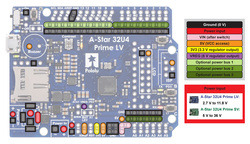 |
A-Star 32U4 Prime power distribution diagram (original ac03b version). |
|---|
Like the A-Star 32U4 Prime LV, the SV has a bunch of features designed to make it easy for you to make use of the power. The TPS2113A USB power mux allows you to safely and seamlessly switch between a battery and USB power (up to 1.5 A using a powerful enough USB supply), without the limitations of diodes or fuses. We included a handy power switch for your external power input, extra connection options in case you don’t want to use the standard DC power jack, extra access points for the important power nodes VIN, VREG, 5V, and 3V3, and big power and ground buses.
The A-Star 32U4 Prime SV includes all the same peripheral features as the A-Star 32U4 Prime LV: battery voltage monitoring, three user pushbuttons (sharing the MISO, RXLED, and TXLED lines), a buzzer optionally controlled by digital pin 6, a connector for an HD44780-based character LCD, and – on some models – a microSD card slot that works with the Arduino SD library. Here is an SV with all the optional peripherals installed:
 |
You can purchase this configuration pre-assembled as Pololu item #3115, or get it with almost everything but the LCD as Pololu item #3114. (You can still install an LCD yourself later.) For other configuration options, please see the individual product pages below or the A-Star 32U4 Prime SV category page.
New product: A-Star 32U4 Prime LV
The A-Star 32U4 Prime LV is the newest member of our A-Star family of programmable microcontroller boards. This is the first Pololu board with the familiar Arduino shape: it shares the pinout of the Arduino Leonardo and should work with Leonardo-compatible shields. With some code changes, this A-Star can also serve as a substitute for the similar Arduino Uno in many projects. However, there is a lot more to it than Arduino compatibility!
 |
Unlike the Uno and Leonardo, the A-Star Prime has an efficient 5 V switching regulator and a seamless USB power switching circuit. This “LV” model uses the same power circuit, based on the Texas Instruments TPS63061 and TPS2113A, as the A-Star 32U4 Mini LV. Like that board, the A-Star 32U4 Prime LV can operate from 2.7 V to 11.8 V and supply about 1 A at 5 V, safely and efficiently switching between USB and external power without the limitations of components like fuses or diodes. It also includes a power switch, multiple power input connection points, and optional battery voltage monitoring, making it convenient to use in a variety of power supply scenarios. Here is a diagram of power distribution on the board:
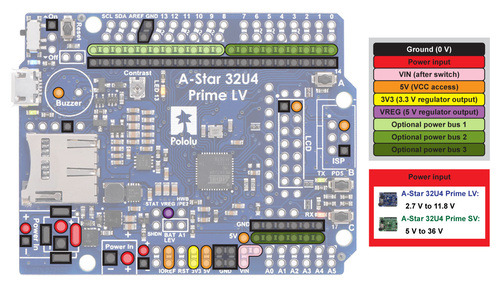 |
As you can see in the pictures, there are few extra rows of pins next to the normal Arduino headers. The point of these is to give you more connection options: we have included an extra access point (on a 0.1" grid) for most of the pins, as well as extra power and ground buses. The power buses are unconnected by default, so you could, for example, wire VIN directly to a bus and solder in servo connectors in one place (the LV regulator works great on a four- or five-cell NiMH pack), while having another bus run at 3.3 V to power an array of low-voltage sensors. As another example, these buses are a convenient place to add your own custom pull-up or pull-down resistors.
There is a lot of space available in this form factor compared to the typical Pololu breakout board, and we hate to waste space, so we packed it with extra, optional peripherals:
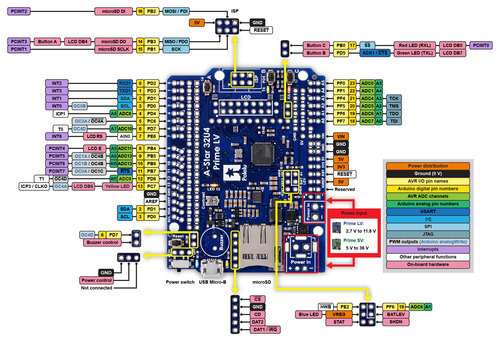 |
You might recognize some of the optional peripherals from our line of Orangutan Robot Controllers and the 3pi Robot. These are features that we have found really handy in our projects over the years: three user pushbuttons (sharing the MISO, RXLED, and TXLED lines), a buzzer for beeps and simple music (optionally controlled by digital pin 6), and a connector for an HD44780-based character LCD. You can enable just the features you want with jumpers; the ones you do not use will not interfere with shields or other electronics. On some models, we are also including a microSD card slot that works with the Arduino SD library, so you can easily turn your A-Star Prime into a datalogger or access large scripts and media files.
Here is what the A-Star 32U4 Prime LV looks like with all optional peripherals installed:
 |
This configuration is available pre-assembled as Pololu item #3109, while a configuration including pretty much everything but the LCD is available as Pololu item #3108. (You can still install an LCD yourself later.) For other configuration options, please see the individual product pages below or the A-Star 32U4 Prime LV category page.
Simple Animatronic Skull
If you have been following our blog, you have seen some fun and scary Halloween projects posted by my coworkers here at Pololu. Well, this is the first part of my prop for my costume for this upcoming Halloween. After watching an animatronic devil baby terrorize New York City, I knew I wanted to build a similar demon baby that would be attached to me with a baby carrier. Continued…
Two new motor driver shields for Arduino
We are excited to announce the addition of two new motor drivers to our selection of Arduino shields: the Pololu DRV8835 Dual Motor Driver Shield for Arduino and the Pololu A4990 Dual Motor Driver Shield for Arduino. These miniature shields are low-cost, basic dual motor drivers for your Arduino or Arduino-compatible board. When connected to an Arduino, each provides two channels of bidirectional PWM motor control suitable for driving small brushed DC motors. The boards include various handy features like reverse protection, multiple power and motor connection options, and the ability to customize some of the pin mappings. Our open-source libraries provide a convenient way to get started controlling these motors with an Arduino.
Selecting a motor driver shield
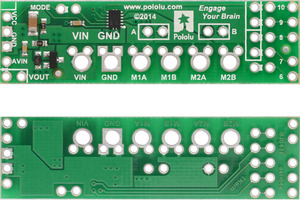 |
Pololu DRV8835 Dual Motor Driver Shield for Arduino, top and bottom sides. |
|---|
 |
Pololu A4990 Dual Motor Driver Shield for Arduino, top and bottom sides. |
|---|
The main practical difference between the shields is their input voltage range, so most people should probably select a shield based on their desired power supply. Here are some details:
Our DRV8835 shield, based on the DRV8835 motor driver from Texas Instruments, has an input voltage range of 2 V to 11 V and can deliver a continuous 1.2 A (1.5 A peak) on each channel. It is suitable, for example, for battery-powered robots similar to the 3pi or Zumo. As a bonus feature of our shield, you can parallel the motor outputs to get a single channel with twice the current capability.
Our A4990 shield uses the Allegro A4990 and is specifically intended for higher-voltage applications, such as projects powered by a 12 V or 24 V battery. It has an input voltage range of 6 V to 32 V and can deliver a continuous 0.65 A (0.9 A peak) per channel. The A4990 can detect and signal a variety of errors like over-temperature and short-circuit, allowing more sophisticated control and monitoring.
We also carry higher-power shields based on the MC33926 and VNH5019.
Basic breakout boards available
For applications where an Arduino shield does not make sense, we also offer basic breakout boards for the DRV8835 and A4990 that provide access to all of the features of these great chips.
Congratulations to our summer interns!
If you carefully inspect the back of the boards, you will notice “TKern” and “izzyg” etched in copper. These inscriptions commemorate the internships of Ted Kern and Ismael “Izzy” Gomez, Las Vegas natives who were indoctrinated in Pololu design philosophies this summer while creating these new products. We wish Ted and Izzy good luck as they head/return to college at CMU and MIT!
New products: CC3000 Wi-Fi breakout board and Arduino shield from Adafruit
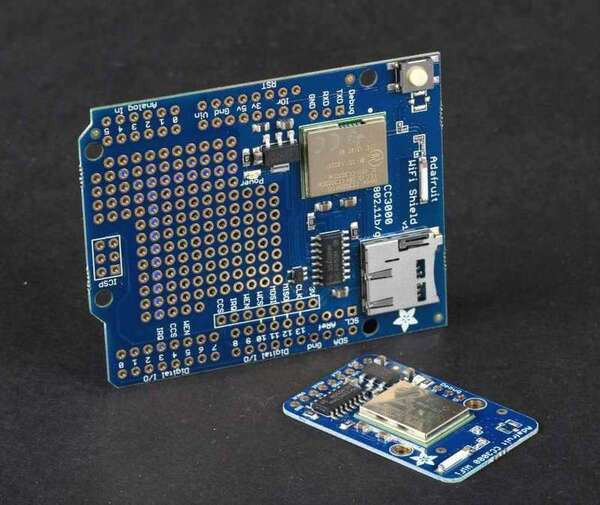 |
Adding wireless connectivity to an electronics project is a great way to enhance functionality and make it stand out. Our selection of wireless electronics includes radio frequency modules, such as the Wixel, and Bluetooth modules, like the BlueSMiRF Silver from SparkFun, but until recently, we did not carry a good solution to adding Wi-Fi to a project. That’s where the newest additions to our wireless selection come into play.
We are now carrying two CC3000 Wi-Fi module carrier boards from Adafruit: the CC3000 Wi-Fi Shield for Arduino and CC3000 Wi-Fi breakout board. The CC3000 is a self-contained wireless network processor with an SPI interface, so it is not limited to a fixed UART baud rate, and the Adafruit carrier boards include level shifters, so they should be simple to connect to almost any microcontroller. Adafruit’s CC3000 Arduino library and example sketches make them especially easy to use with an Arduino-compatible board.
|
|
The CC3000 Wi-Fi Shield for Arduino offers a MicroSD card socket, a prototyping area for soldering extra circuitry, and a button for resetting the Arduino. The CC3000 Wi-Fi breakout board (v1.1) is much more compact and is also breadboard-compatible. Both products include an onboard ceramic antenna.
New products: A-Star 32U4 Minis
A few months ago, we released the A-Star 32U4 Micro, a general-purpose microcontroller breakout board based on the Atmel ATmega32U4, and we discussed our plans to extend the design with additional integrated features. Today, we are thrilled to announce a major expansion of the family with the introduction of the A-Star 32U4 Mini ULV, A-Star 32U4 Mini LV, and A-Star 32U4 Mini SV.
 |
A-Star 32U4 Mini pinout diagram (listed SV voltage range is for original ac02c version). |
|---|
Like the A-Star Micro, the A-Star Minis are Arduino-compatible boards based on the ATmega32U4. The Minis are expanded boards that provide access to almost all of the pins of the AVR (including a few more than the Arduino Leonardo and Arduino Micro), but what really sets them apart from competing products are their efficient power supply systems based on switching regulators. Each model is based on a different voltage regulator, and its name includes a designation corresponding to its input voltage range:
- A-Star 32U4 Mini ULV (Ultra-Low Voltage): 0.5 V to 5.5 V
- A-Star 32U4 Mini LV (Low Voltage): 2.7 V to 11.8 V
- A-Star 32U4 Mini SV (Standard Voltage): 5 V to 36 V
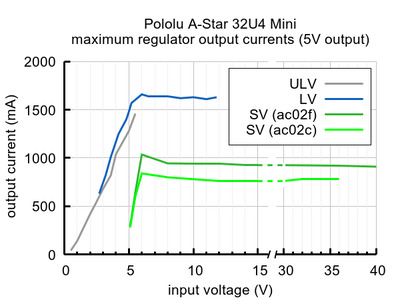 |
Typical maximum output current of the regulators on the A-Star 32U4 Mini boards. |
|---|
The regulator designs are closely related to some of our favorite voltage regulator boards, the U1V11F5, S7V8F5, and D24V5F5. Taken together, this range of options lets you power your project with anything from a single NiMH cell to a 24 V lead-acid battery or an 8-cell LiPo pack. With typical currents of 500 mA to 1 A, you get plenty of 5 V power for your AVR and an array of peripheral devices, or at the other end of the scale, these regulators allow your project to make effective use of low-power modes on the AVR, potentially operating on a battery for months at a time.
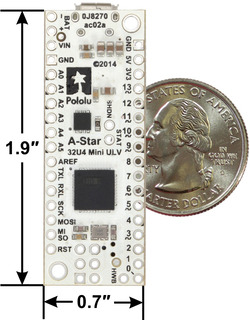 |
A-Star 32U4 Mini ULV, bottom view with dimensions. |
|---|
Another exciting feature of the power supply system on the A-Star Minis is seamless USB power switching provided by an onboard TPS2113A power multiplexer. This means that you can safely connect both USB and external power, and you can monitor or control the selected supply, without losing power or shorting your supplies together.
We think that the A-Star Minis are by far the most capable AVR breakout boards for their size, and they should be an excellent choice for almost any project needing a compact, Arduino-compatible controller. We have priced them so that it should be an easy choice, too. For more information or to order, see the A-Star controller category.
New version of the Zumo Shield for Arduino - now with full IMU!
 |
We posted recently about how progress in MEMS sensors has resulted in a constant stream of improved Pololu breakout boards. This week, we brought some of that technological progress to our Zumo robot with the release of a new “v1.2” version of the Zumo Shield for Arduino. This new version upgrades the previously-included LSM303DLHC compass to nine channels of inertial sensing using the newer LSM303D compass and L3GD20H gyroscope.
That means that the new Zumo shield includes a full inertial measurement unit (IMU) – the equivalent of a MinIMU-9 v3 – letting you turn it into a complete AHRS by adding an Arduino or compatible controller.
The v1.2 update extends to three new products:
- Zumo Shield for Arduino, v1.2
- Zumo Robot Kit for Arduino, v1.2 (No Motors)
- Zumo Robot for Arduino, v1.2 (Assembled with 75:1 HP Motors)
Other parts, such as the Zumo chassis, sumo blade, and reflectance sensor array, are not affected by this update, and the new Zumo shield is mechanically and electrically compatible with the previous model. They are also completely code-compatible except for the MEMS sensor aspects, which are already supported by our open-source Arduino libraries.
New product: A-Star 32U4 Micro
Today we released a general-purpose AVR microcontroller breakout board, the A-Star 32U4 Micro. But before I get to the A-Star (A* for short), I would like to mention some of our history with AVR boards.
Some of our history with AVR boards
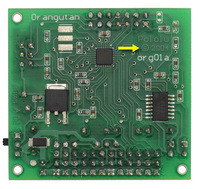 |
Original Orangutan Robot Controller (back view) from 2004. |
|---|
It has been almost ten years since we introduced our Orangutan Robot Controller, which featured an AVR microcontroller, dual motor drivers, and user-friendly features like a display and buzzer. Over the years we expanded the line, making larger, more complicated Orangutans like the Orangutan SVP as well as the miniature Baby Orangutan.
I have used the Baby Orangutan in many of my own projects, because I like its simplicity and small size. Ironically, the built-in motor driver gets in the way when I want to use a newer motor driver such as the DRV8835 in a project, since valuable PWM pins are unavailable. So I have built my more recent robots using minimal microcontroller breakout boards without motor drivers, such as Arduinos and the Wixel. (I posted about my latest such project last week.)
Our focus has been on boards that include motor drivers, and we have not had a really simple microcontroller board for people who don’t want the motor driver. Even though there are far more powerful controllers available, 8-bit AVR microcontrollers continue to be popular in the community, and the basic AVR breakout board is something we have wanted to make for a long time.
 |
Original ATmega168-based Baby Orangutan robot controller from 2005 (left) next to A-Star 32U4 Micro boards. |
|---|
Introducing the A-Star 32U4 Micro
That is why I am excited today to announce the A-Star 32U4 Micro, a Pololu breakout board for Atmel’s ATmega32U4 AVR microcontroller:
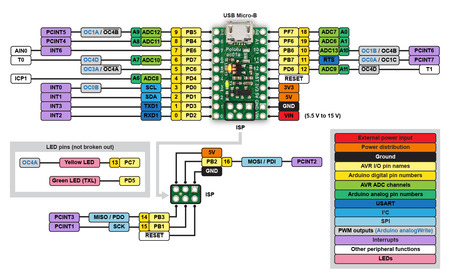 |
A-Star 32U4 Micro pinout diagram. |
|---|
Compared to the popular ATmega328P microcontroller that we used on several Orangutan models, the ATmega32U4 is a newer processor with features like more analog inputs, more PWM outputs, and, most importantly, USB support. The USB connection, which we have broken out to a Micro-B connector, makes programming easy and enables interesting projects involving connections to a PC.
Also, since the ATmega32U4 is used on the Arduino Leonardo, Arduino Micro, and many other breakout boards, there is a large community with experience using the microcontroller. To support this community, we are shipping the A* with an Arduino-compatible bootloader and have followed Arduino conventions including pin numbering and LED connections.
Since we wanted to make a minimal breakout board, we decided to make it as small as we could, hoping that it would be small and cheap enough to go into (and stay in) almost any project. The result is that the A-Star 32U4 Micro is, as far as we know, the smallest ATmega32U4 breakout board available. It is even smaller than some AVR boards with less powerful microcontrollers that implement USB support in software and have only a few general-purpose I/O lines available.
 |
The Pololu A-Star 32U4 Micro is about half the size of an Arduino Micro. |
|---|
Now that we have reached a reasonable extreme on the minimal end, we intend to expand back toward more integrated features, eventually replacing our older Orangutan robot controllers with versions offering more modern power handling and perhaps other features like inertial measurement sensors. What would you like to see in an integrated robotics or automation controller? Did we leave out too much on the A-Star 32U4 Micro? Please let us know in the comment section.
For more information, see the A-Star 32U4 Micro product page.
LED strip code used in Pololu Christmas video
We added the code we used for the LEDs in our Christmas video last week to our GitHub page. Ben cleaned it up a bit and added lots of comments, so we hope it’s helpful if you want to use it as a base to write some awesome sequences for your own LED strips.
In case you missed the video, here it is again:
A Pololu Christmas Story (with LEDs!)
Merry Christmas! We got some new LED strips in a week or so ago that are based on the WS2812B. I was pretty excited to play around with them, so I decided I would decorate Ben’s house and make him film this video with me. (I know. I should have decorated my own house, but I live far from the office… and don’t have a wife.)
We should have the code we used for the LEDs available on our github page in a couple of days.
